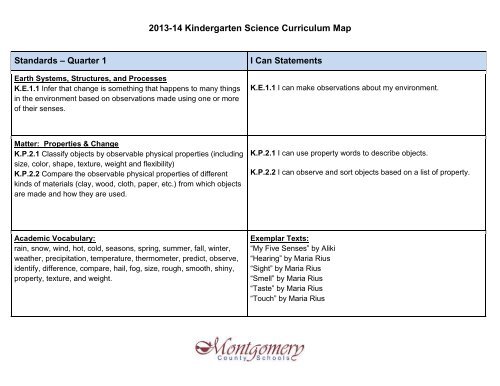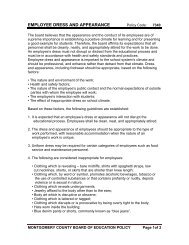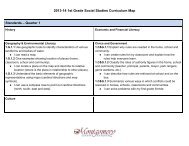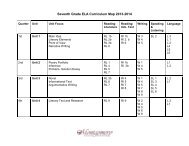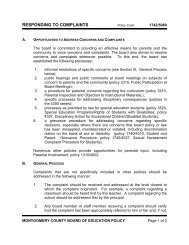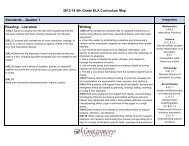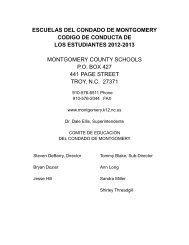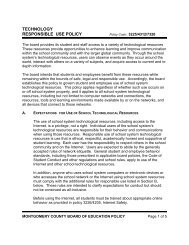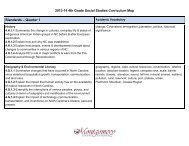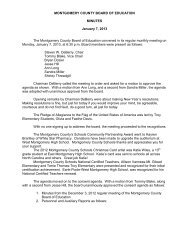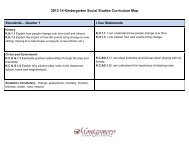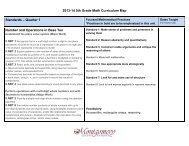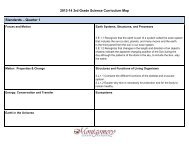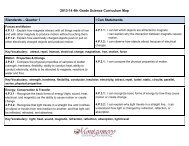2013-14 Kindergarten Science Curriculum Map Standards â Quarter ...
2013-14 Kindergarten Science Curriculum Map Standards â Quarter ...
2013-14 Kindergarten Science Curriculum Map Standards â Quarter ...
You also want an ePaper? Increase the reach of your titles
YUMPU automatically turns print PDFs into web optimized ePapers that Google loves.
<strong>2013</strong>-<strong>14</strong> <strong>Kindergarten</strong> <strong>Science</strong> <strong>Curriculum</strong> <strong>Map</strong><br />
<strong>Standards</strong> – <strong>Quarter</strong> 1<br />
Earth Systems, Structures, and Processes<br />
K.E.1.1 Infer that change is something that happens to many things<br />
in the environment based on observations made using one or more<br />
of their senses.<br />
I Can Statements<br />
K.E.1.1 I can make observations about my environment.<br />
Matter: Properties & Change<br />
K.P.2.1 Classify objects by observable physical properties (including<br />
size, color, shape, texture, weight and flexibility)<br />
K.P.2.2 Compare the observable physical properties of different<br />
kinds of materials (clay, wood, cloth, paper, etc.) from which objects<br />
are made and how they are used.<br />
K.P.2.1 I can use property words to describe objects.<br />
K.P.2.2 I can observe and sort objects based on a list of property.<br />
Academic Vocabulary:<br />
rain, snow, wind, hot, cold, seasons, spring, summer, fall, winter,<br />
weather, precipitation, temperature, thermometer, predict, observe,<br />
identify, difference, compare, hail, fog, size, rough, smooth, shiny,<br />
property, texture, and weight.<br />
Exemplar Texts:<br />
“My Five Senses” by Aliki<br />
“Hearing” by Maria Rius<br />
“Sight” by Maria Rius<br />
“Smell” by Maria Rius<br />
“Taste” by Maria Rius<br />
“Touch” by Maria Rius
<strong>2013</strong>-<strong>14</strong> <strong>Kindergarten</strong> <strong>Science</strong> <strong>Curriculum</strong> <strong>Map</strong><br />
<strong>Standards</strong> – <strong>Quarter</strong> 2<br />
Forces and Motion<br />
K.P.1.1 Compare the relative position of various objects observed in<br />
the classroom and outside using positional words such as: in front of,<br />
behind, between, on top of, under, above, below and beside.<br />
K.P.1.2 Give examples of different ways objects and organisms move<br />
(to include falling to the ground when dropped ):<br />
• Straight<br />
• Zigzag<br />
• Round and round • Back and forth<br />
• Fast and slow<br />
I Can Statements<br />
K.P.1.1 I can understand the differences between positional words.<br />
K.P.1.2 I can understand different ways that living and nonliving<br />
things can move.<br />
Structures and Functions of Living Organisms<br />
K.L.1.1 Compare different types of the same animal (i.e. different<br />
types of dogs, different types of cats, etc.) to determine individual<br />
differences within a particular type of animal.<br />
K.L.1.2 Compare characteristics of living and nonliving things in<br />
terms of their:<br />
• Structure<br />
• Growth<br />
• Changes<br />
• Movement<br />
• Basic needs<br />
K.L.1.1 I can identify ways that animals of the same type have<br />
different attributes.<br />
K.L.1.2 I can compare living and nonliving things by using terms all<br />
animals share.<br />
Academic Vocabulary: under, fast, over, slow, top, bend, behind,<br />
straight, zigzag, colored, above, below, shape, size, between, bottom,<br />
front, classify, sort, beneath, living, compare, nonliving, needs,<br />
differences, growth, changes, characteristics, structure, and individual.
<strong>2013</strong>-<strong>14</strong> <strong>Kindergarten</strong> <strong>Science</strong> <strong>Curriculum</strong> <strong>Map</strong><br />
<strong>Standards</strong> – <strong>Quarter</strong> 3<br />
Earth Systems, Structures, and Processes<br />
K.E.1.2 Summarize daily weather conditions noting changes that<br />
occur from day to day and throughout the year<br />
I Can Statements<br />
K.E.1.2 I can use my observations to notice that it can be cloudy one<br />
day and sunny another day.<br />
Academic Vocabulary: rain, snow, wind, hot, cold, seasons, spring,<br />
summer, fall, winter, weather, precipitation, temperature,<br />
thermometer, predict, observe, identify, difference, compare, hail,<br />
and fog.
<strong>2013</strong>-<strong>14</strong> <strong>Kindergarten</strong> <strong>Science</strong> <strong>Curriculum</strong> <strong>Map</strong><br />
<strong>Standards</strong> – <strong>Quarter</strong> 4<br />
Earth Systems, Structures, and Processes<br />
K.E.1.3 Compare weather patterns that occur from season to<br />
season.<br />
I Can Statements<br />
K.E.1.3 I can use observations to decide that weather is different<br />
from season to season.<br />
Structures and Functions of Living Organisms<br />
K.L.1.1 Compare different types of the same animal (i.e. different<br />
types of dogs, different types of cats, etc.) to determine individual<br />
differences within a particular type of animal.<br />
K.L.1.2 Compare characteristics of living and nonliving things in<br />
terms of their:<br />
• Structure • Growth • Changes<br />
• Movement • Basic needs<br />
K.L.1.1 I can identify ways that animals of the same type have<br />
different attributes.<br />
K.L.1.2 I can compare living and nonliving things by using terms all<br />
animals share.<br />
Academic Vocabulary: rain, snow, wind, hot, cold, seasons, spring,<br />
summer, fall, winter, weather, precipitation, temperature,<br />
thermometer, predict, observe, identify, difference, compare, hail,<br />
fog, living, movement, compare, nonliving, needs, differences,<br />
growth, changes, characteristics, structure, and individual.


